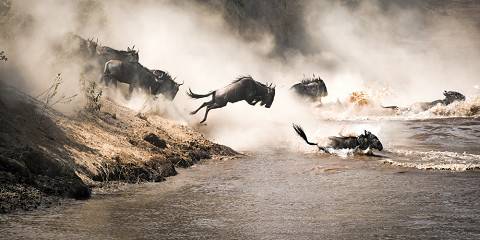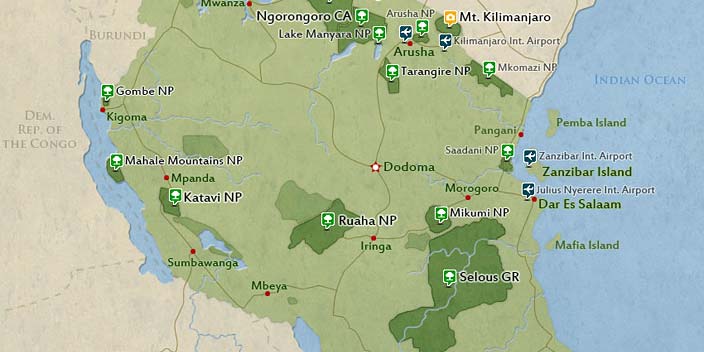
$2,775 pp (USD)
2 travelers on Start dateArrival
Arrival

Day 1
Arusha to Tarangire National Park
Arusha to Tarangire National Park
You will be picked up in the morning from your hotel after breakfast and after a short briefing, you will head off in the direction of the Tarangire National Park.
The park's natural habitat is a savannah surrounded by baobab trees and seasonal swamps, which is the home to huge elephant herds. The park also includes several mammals ranging from giraffes, bushbucks, and hartebeests to zebras and warthogs. Besides, some of the most aggressive African predators like, lions, leopards, and cheetahs are rarely spotted here.
This will be an awe-inspiring experience to watch the wandering animals from the open roof of our safari vehicle. You will head to the campsite in the late afternoon for the rest and the overnight stay.
- Main Destination:
- Tarangire National Park
- Accommodation:
- Budget camping
- Meals & Drinks:

Day 2
Tarangire National Park to Lake Natron
Tarangire National Park to Lake Natron
On this day, you will travel to Lake Natron, a wild and remote village. It is situated at the base of Africa’s only active volcano, Oldoinyo Lengai, which is known as the 'Mountain of God' by the Maasai people. The area around Lake Natron contains some of the most harsh and amazing scenery in Africa and is utterly breathtaking for those clients who choose to travel off the beaten track.
Together with your guide, you will be accompanied by a local Maasai guide and walk up to the Engero Sero Waterfalls. Winding up through the shady gorge you will reach a beautiful natural swimming pool surrounded by steep rock walls showered by cascading spring water where you will have the opportunity to swim.
- Main Destination:
- Lake Natron
- Accommodation:
- Budget camping
- Meals & Drinks:

Day 3
Lake Natron Excursion and Trekking
Lake Natron Excursion and Trekking
On this day, right after your breakfast, you will spend your morning time enjoying the flamingos at Lake Natron for a few hours. Lake Natron is alkaline in nature, which is advantageous to flamingos because, being alkaline, it provides bacteria to grow, and hence flamingos can survive since they can obtain food from it. The lake serves as the principal breeding site for three-quarters of the world’s population of lesser flamingos. After you have enjoyed your beautiful view of flamingos around the lake, you will then walk back to the camp to take a rest as you wait for the midnight call to trek the Ol Doinyo Lengai around (10.00 pm). We recommend you to take time to rest enough, as you will be waking up in the night.
- Main Destination:
- Lake Natron
- Accommodation:
- Budget camping
- Meals & Drinks:

Day 4
Trekking Ol Doinyo Lengai Mountain and Driving to Serengeti
Trekking Ol Doinyo Lengai Mountain and Driving to Serengeti
Remember trekking will start on the night of the 3rd day. Everything is prepared prior, you won’t have a lot of time spent in preparation. The trekking itinerary will be as follows.
10:00 pm (day 3): You'll wake up for tea/coffee and snacks before driving to the base of Ol Doinyo Lengai.
11:30 pm: You'll arrive at the base of Ol Doinyo Lengai and start your ascent
5:30 am: You'll be at the top of Ol Doinyo Lengai! (On clear days, you will witness and enjoy the amazing sunrise as it illuminates the Great Rift Valley)
6:00 am (day 4): You'll start your descent.
9:00 am: You'll arrive at the base of Ol Doinyo Lengai and drive back to the Camp.
10:00 am: You'll arrive at the lodge and be greeted by a cold face towel and fresh cold drink to quench your thirst then take your heavy breakfast.
Noon: You'll have a late lunch along the way as you drive to Serengeti National Park.
Please note that these timings are average estimates.
- Main Destination:
- Ol Doinyo Lengai
- Accommodation:
- Budget camping
- Meals & Drinks:

Day 5
Serengeti National Park
Serengeti National Park
You should wake up early to take part in a sunrise game drive. As the sun sets vigor to the savannah, you'll have the best opportunity to see predators in action as they take advantage of the low light and cooler temperatures to look for an early meal. It's an ideal time to see lions, leopards, and cheetahs in action as well as the early morning movements of the wildebeest, zebra, and other herbivores.
Alternatively, you may wish to take to the skies a sunrise hot air balloon safari, and champagne breakfast. Speak to us about adding this, once-in-a-lifetime experience to your safari itinerary at an extra cost.
After your unforgettable morning, you'll return to your lodge for a late breakfast and to freshen up before hitting the road again with a packed picnic lunch. Your driver will select the best possible route based on the time of year and the kind of animals you'd like to see, catering your day so that your opportunities to see the Serengeti's diverse wildlife are maximized.
- Main Destination:
- Serengeti National Park
- Accommodation:
- Budget camping
- Meals & Drinks:

Day 6
Serengeti National Park
Serengeti National Park
The entire day is dedicated to wildlife viewing in the Serengeti National Park. You will either go on a full-day game drive or join early morning and afternoon drives in the Seronera area, depending on last night’s stop. The best time to find the wild beasts here is between December and May and for the calving session January and March are the right season to visit. The Seronera area is also the best place to spot the shy and nocturnal leopard. You will spend the night at the same campsite.
- Main Destination:
- Serengeti National Park
- Accommodation:
- Budget camping
- Meals & Drinks:

Day 7
Serengeti to Ngorongoro Conservation Area
Serengeti to Ngorongoro Conservation Area
The morning is set aside for another game drive in the Serengeti and you might spot some creatures that you haven’t seen yet. Animals tend to be more active in the morning before the temperatures soar around midday. After lunch, you will leave the plains of the Serengeti and travel to the highlands of the Ngorongoro Conservation Area. You will spend the night at Simba Camp directly on the Ngorongoro Crater’s edge with a view over the collapsed volcano. It is a perfect spot to enjoy a sunset.
Please note that due to the high-altitude location of Simba Campsite, temperatures can drop at night. We recommend bringing extra layers to wear during the evening and the following morning.
- Main Destination:
- Ngorongoro Crater
- Accommodation:
- Budget camping
- Meals & Drinks:

Day 8
Ngorongoro Crater to Mto wa Mbu
Ngorongoro Crater to Mto wa Mbu
It is up at daybreak to take on the steep path leading down into the 600-meter crater. The slopes are forested but soon the landscape changes to savannah with the occasional acacia tree here and there. The wildlife in the crater is just breathtaking and with a little luck you might see the Big Five —lion, elephant, buffalo, rhino, and leopard. You will see warthogs, several groups of wildebeests, zebras, hippos, and more than 500 bird species in the area. After an entire morning of wildlife viewing and a picnic lunch in the crater, you will travel to Mto wa Mbu where you will spend a night at a campsite.
- Main Destination:
- Ngorongoro Crater
- Accommodation:
- Budget camping
- Meals & Drinks:

Day 9
Lake Manyara National Park to Moshi/Arusha
Lake Manyara National Park to Moshi/Arusha
After a restful breakfast, you will be driven to Lake Manyara National Park. Not only is this park a bird-lovers paradise with over 400 species of birds, but also home to primates such as baboons and blue monkeys and many herbivores like elephants, hippos, wildebeest, impalas, and giraffes. You might even catch a glimpse of the more carnivorous inhabitants, like leopards and lions just to mention a few. Through the pop-up roof of your safari vehicle, you will see the landscape changing from lush acacia woodlands to grassy floodplains, where colonies of flamingos and other waterfowls can be found on the alkaline Lake Manyara shoreline. After extensive wildlife viewing, you will leave the park and you will start your return trip to Moshi/Arusha. You will be dropped off at a hotel of your choice or the airport.
- Main Destination:
- Lake Manyara National Park
- Accommodation:
- No accommodation (End of tour)
- Meals & Drinks:
















